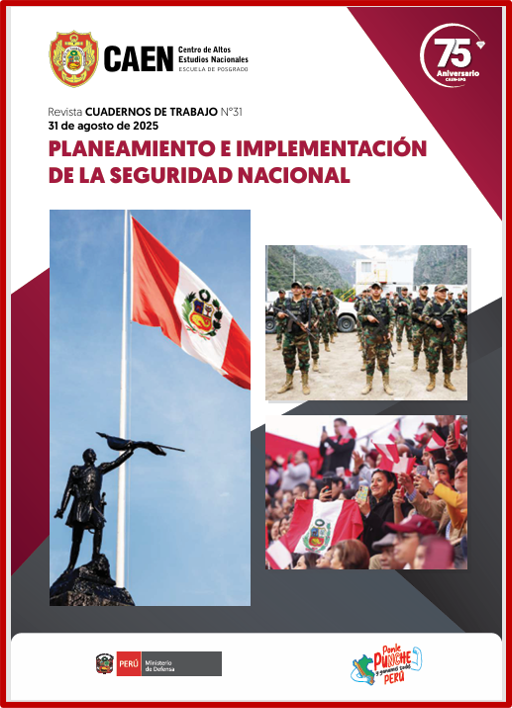Self-defense Committees Against Crime in Pataz
DOI:
https://doi.org/10.58211/ddwnh106Abstract
This article analyzes the security situation in the province of Pataz, La Libertad region, marked by the expansion of illegal mining, the presence of organized crime, and structural violence. Based on a historical and operational review, the role of Self-Defense Committees (SDCs) as legitimate community security structures is examined. Their role in the fight against terrorism during the era of terrorist violence in Peru, their subsequent deactivation, and their potential usefulness in the current context are described. The experience of the 13th Motorized Infantry Battalion in Tayabamba (2002) is presented as a case study, which demonstrated the effectiveness of coordination between the Armed Forces, the Peruvian National Police, and SDCs, even without a declared state of emergency. Through an analysis of the regulatory framework, specifically Law No. 31494, legal gaps are identified that limit the formal reactivation of these structures. The article proposes the legal, technical, and strategic reactivation of SDCs in strategic rural areas as a complement to state action. In addition, an expanded national security agenda is presented with structural measures in defense, justice, technology, and territorial governance, articulated from a multisectoral perspective and with citizen participation.
References
Boutron, C. (2012). Reintegrating Civilian Life after Combat: Between Invisibility and Resistance. The Experience of the Ronderas in Peru (pp. 73–93). Palgrave Macmillan, New York. https://doi.org/10.1057/9781137109743_4
Comisión de la Verdad y Reconciliación (CVR). (2003). Informe Final. Presidencia del Consejo de Ministros. https://www.cverdad.org.pe
Congreso de la República del Perú. (2022). Ley N.º 31494: Ley que reconoce a los Comités de Autodefensa y Desarrollo Rural y regula su accionar. Diario Oficial El Peruano. https://busquedas.elperuano.pe/dispositivo/NL/2077948-2
Defensoría del Pueblo. (2018). Informe defensorial N.º 160. https://www.defensoria.gob.pe/wp-content/uploads/2018/05/informe-defensorial-160.pdf
Defensoría del Pueblo. (2024). Reporte de Conflictos Sociales N.º 241 – marzo 2024. https://www.defensoria.gob.pe/wp-content/uploads/2024/04/ReporteConflictos_marzo2024.pdf
Degregori, C. I. (1998). Jamás tan cerca arremetió lo lejos: Memoria y violencia política en el Perú. Instituto de Estudios Peruanos.
Fumerton, M. A. (2018). Beyond Counterinsurgency: Peasant Militias and Wartime Social Order in Peru’s Civil War. European Review of Latin American and Caribbean Studies, 105(105), 61–86. https://doi.org/10.18352/ERLACS.10374
Instituto Nacional de Estadística e Informática (INEI). (2023). Producto Bruto Interno por departamentos 2022. https://www.inei.gob.pe
Instituto Nacional de Estadística e Informática. (2025). Boletín de estadísticas de seguridad ciudadana. Julio – diciembre 2024.
https://m.inei.gob.pe/media/MenuRecursivo/boletines/boletin_seguridad_jul_dic2024.pdf
Ministerio de Defensa del Perú. (1992). Decreto Supremo N.º 077-92-DE: Reglamento de Organización y Funciones de los Comités de Autodefensa. Diario Oficial El Peruano.
Ministerio de Energía y Minas del Perú (MINEM). (2025). Boletín Estadístico Minero – Febrero 2025. Dirección General de Promoción y Sostenibilidad Minera. https://www.gob.pe/institucion/minem/informes-publicaciones/6675429-boletin-estadistico-minero-febrero-2025
Tribunal Constitucional del Perú. (2024). Sentencia del expediente 00007-2022-PI/TC. https://tc.gob.pe/jurisprudencia/2024/00007-2022-AI.html
Willems, E. (2022). ‘I have used up my entire youth in the bush’: the Comités de Autodefensa during and after the Peruvian internal armed conflict. Crime, Law and Social Change, 79, 457–486. https://doi.org/10.1007/s10611-022-10049-8
Downloads
Published
Issue
Section
License
Copyright (c) 2025 Pedro Gerardo Rejas Tataje, Alejandro Muñante Barrios, María Lorena Bustamante Durán

This work is licensed under a Creative Commons Attribution 4.0 International License.





